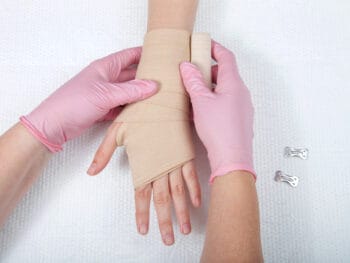
Finding a Home to Renovate – Effective Injury Response
Like a broken home, the employee who suffers a work injury is in need of help and tender loving care. A fast and effective response to every work injury, no matter how minor, can pay dividends in the future.
Click Link to Access Free PDF Download
“13 Research Studies to Prove Value of Return-to-Work Program & Gain Stakeholder Buy-In”
All workplaces need to have a plan in place to deal with work injuries. This includes the accessibility of first aid kits and other medical equipment. Factors to consider include having a plan for all types of injuries and emergencies, making employees aware of the plan and proper implementation. Do not forget that even if your company is not required to have one, the inclusion of a safety chair and emergency response team can assist in a program renovation. This team can be used for the following tasks:
- Maintenance and use of various fire extinguishers;
- Knowledge and ability to perform cardiopulmonary resuscitation (CPR);
- Understanding on how to contain and dispose of bloodborne pathogens;
- Proper chemical handling, storage and containment procedures; and
- Dealing with and responding to incidents involving hazardous materials and workplace fumes.
Other items to consider should include teaching employees basic first aid and other features such as lifesaving equipment that can include a portable defibrillator.
Fixing Up the Property – Workplace Ergonomics and Safety
A great way to ensure a safe workplace should include a review of workplace ergonomics. This can include features such as assessing risks in the workplace on an ongoing basis, correcting the problems and encourage physical health. Suggestions can include:
- Onsight or easily accessible health clinics that include vaccinations, immunizations, and wellness information;
- Encouragement to use a gym or health club – be sure to include discounts on medical insurance for frequent users. Onsite stretching activities, yoga, and mindfulness can also promote a safe work environment; and
- Training on preventing and dealing with workplace violence and “active shooter” situations.
Flippin’ the House for Profit – Ongoing Employee Satisfaction
Like a completely remodeled home, a workers’ compensation program that is in pristine shape will add value and create its own demand. This will improve company morale and improve return to work rates following an injury. Interested stakeholders should look for opportunities to add value through a workers’ compensation program’s “curb appeal.” This can be accomplished by promoting medical and behavioral health consultations to assist employees manage their lives in and outside the workplace – and enhance one’s work/life balance.
FREE DOWNLOAD: “13 Research Studies to Prove Value of Return-to-Work Program & Gain Stakeholder Buy-In”
Addressing the needs of employees mental health needs is important in today’s fast-paced society. This is especially the case when employees work during a clinic’s hours of operation. By making these services available to employees on-site or at a convenient location, people are more willing to receive the care they may need.
Addressing the mental health needs of all employees are important both before and after a work injury. Studies suggest that people who receive mental health counseling following a work injury have a lower chance of re-injury or malingering. This translates into lower workers’ compensation insurance premiums.
Conclusions
Members of the claims management team should seek to climb the property ladder to add value and reduce costs to a workers’ compensation program. This includes simple steps that can be taken to renovate a program, make it better and increase its value. When a program is strong, it also adds value to the clients it serves.

Contact: mstack@reduceyourworkerscomp.com.
Workers’ Comp Roundup Blog: https://blog.reduceyourworkerscomp.com/
©2018 Amaxx LLC. All rights reserved under International Copyright Law.
Do not use this information without independent verification. All state laws vary. You should consult with your insurance broker, attorney, or qualified professional.














